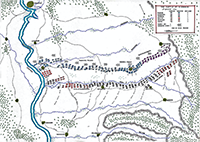King Philip V of Spain
Philip V was King of Spain for more than four decades in the 18th Century. His reign was marked by an extraordinary battle over his taking the throne and by a series of reforms that he oversaw to one degree or another. He was born on Dec. 19, 1683, at the Palace of Versailles, in France. His father was Louis, the heir apparent to the French throne, which was then occupied by Louis XIV. Young Philip's mother was Maria Anna Victoria of Bavaria. Philip was his parents' second son and so was designated Duke of Anjou. (His older brother, Louis, was Duke of Burgundy.) The reigning monarch of Spain at this time was King Charles II. Charles had been ill for most of his life and was certainly ailing while Philip was growing up. Charles had had two wives: Maria Louise d'Orleans (who died in 1689) and Maria Anna of Neuburg. Neither marriage produced a child, and so Charles had no direct heir to his throne. He changed his will a handful of times in his last years, finally settling on young Philip as his heir. The connection was that Louis XIV's wife, Maria Theresa, was the Spanish king's sister. Philip, therefore, was Charles's nephew. Charles died on Nov. 1, 1700, and Philip accepted Spain's offer of the throne. He was named king on November 16. 
A concern for many throughout Europe had been that Philip would one day be king of both France and Spain. He thought that he had prevented that scenario by publicly renouncing any claim to the French throne when he accepted the Spanish throne. Louis XIV had ideas all his own and created a series of international incidents that led to the War of the Spanish Succession. The war pitted France and Spain against most of the rest of Europe. The war lasted 14 years. Ending it was the Treaty of Utrecht, by which all powers recognized Philip V as the rightful heir to the Spanish throne. He had been ruling the country the entire time. Philip had married Maria Luisa of Savoy in 1701; at the time, he was 17, and she was 13. She was popular with the Spanish people and served as regent more than once while Philip was out of the country. The queen died of tuberculosis in 1714; she was 26. Philip and Maria Luisa had by this time had four children. Only one of the four boys, Ferdinand, lived to adulthood. Their first son, Louis, was still alive when his mother died. That same year, Philip V got married again, to Elizabeth of Parma, also known as Elisabeth Farnese. Together, they had six children: Charles, Mariana Victoria, Philip, Maria Teresa, Louis, and Maria Antonia; all lived to adulthood. 
Philip's actions in 1718 led to another version of the war over his succession. He renounced the Treaty of Utrecht and tried to regain territories that he had lost in that previous war. The War of the Quadruple Alliance resulted in a victory for that alliance and, consequently, a loss for Philip. Spanish forces had recovered Sardinia and made a play for Sicily before the consortium of Austria, France, the Dutch Republic, and Great Britain banded together to stop further Spanish expansion. The conflict was wide-ranging, with Spanish troops landing in France at one point and Philip enthusiastically supporting James Stuart, the "Old Pretender," in an attempt to overthrow Britain's King George I. As well, French and Spanish forces fought in the New World, with France taking Pensacola, in Florida, from Spain. The Treaty of Hague, in 1720, ended the war. In 1724, with the country in a state of general stability, Philip V abdicated the throne. His oldest son, Louis, was then 17 and took over the throne. Historians still do not agree on the reasons for Philip's abdication at this time. Philip had relinquished the throne on Jan. 14, 1724. On August 31 of that same year, the new king, Louis, died of smallpox. He had gotten married, to Louise Élisabeth d'Orléans, but the couple had had no children. Philip V reclaimed the throne at that time. As was the case with his predecessors, Philip oversaw the prosecution of a handful of other wars. In the Pacific and the New World, Spanish forces fought against English forces in the War of Jenkins' Ear. Spanish forces also fought in the War of the Polish Succession and in the War of the Austrian Succession. Several acts taken by Philip V laid the groundwork for the modern state of Spain. Philip II had been the first to claim the moniker of King of Spain, but the kingdom was more a collection of historical territories than a centralized whole. Philip V, during and after the war over his succession, eliminated the charters that had governed the historic regions for many years. One motivation for issuing the Nueva Planta decrees, which eliminated those charters, was to punish the nobles in Aragon, who had opposed his succession. Philip also encouraged spending that rebuilt the Spanish navy, largely destroyed along with a large amount of silver in 1702 by Dutch and English forces. At the same time, however, Philip kept in his employ a large number of highly paid government officials, following the example of his predecessors. As a result, Spain in 1739 declared bankruptcy. The king struggled with mental illness at various times in his life. He died after having a stroke, on July 9, 1746 in Madrid. His son succeeded him, becoming King Ferdinand VI. |
|
Social Studies for Kids
copyright 2002–2025
David White




